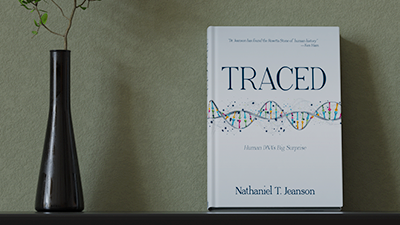
Cooking: The World’s Oldest Profession
Home-cooked meals: secret of our evolutionary leap
News Source
- ScienceNews: “The World’s Oldest Profession: Chef”
Because cooked and processed food is easy to chew, it can be consumed quickly. Harvard researchers wondered if the advent of cooking facilitated the evolutionary leap of human ancestors by leaving them well-fed with more time to think.
“The ancestors of modern humans who invented food processing (including cooking) gained critical advantages in survival and fitness through increased caloric intake,” the researchers write in a study published in the Proceedings of the National Academy of Sciences.1
To assess the amount of time ancient hominids spent eating, the team compared the time people and apes today spend eating. They corrected for body size since being bigger means you need more calories. They found that apes still spend ten times more time chewing their food than people do.
Because humans have smaller molars than apes, the researchers assume that time spent eating correlates with tooth size. Their presumption is that hominids with very small teeth must cook or process food to survive and therefore are also able to eat quickly. On the flip side, big teeth belong to creatures that spend lots of time chewing raw food. Therefore, the team measured the molar size of apes, modern humans, and an assortment of hominid fossils. They used molar size to determine how much time each subject spent eating.
The researchers attribute the evolutionary leaps from apes to “early Homo” to H. erectus and beyond to dietary improvement. According to co-author Chris Organ, “In the big picture, eating cooked food has huge ramifications.” They believe this leap happened because H. erectus became adept at processing food, making it possible to consume nutritious calorie-dense food quickly, leaving more time for intellectual pursuits.
The three hominids supposedly on the evolutionary fast track . . . are all fully human.
The three hominids supposedly on the evolutionary fast track—H. erectus, H. neanderthalensis, and H. sapiens—are all fully human. Despite assertions that H. erectus and H. neanderthalensis were our evolutionary ancestors, genetic evidence has demonstrated that Neanderthals and H. sapiens coexisted and interbred. The cranial capacities of these three all fall within the normal range for modern humans.2 Furthermore, cranial capacity in modern humans does not correlate with intelligence. Since all three have cranial capacities in the modern human spectrum of normality (because they are human), we should not be surprised that their tooth sizes are comparable.
Homo erectus, Homo neanderthalensis, and Homo sapiens all have much smaller teeth than apes suggesting they processed their food and were able to spend less time eating. By contrast, the authors write that “reduction in molar size in early Homo (H. habilis and H. rudolfensis) is explicable by phylogeny and body size alone [emphasis mine].”3 Their final conclusion, however, seems less definite. They write, “Facultative food processing, including cooking, likely originated . . . before the appearance of H. erectus, perhaps even in H. habilis or H. rudolfensis. Although distinct morphological correlates of feeding time are difficult to distinguish in these species, inference of feeding time based on body size and phylogenetic position suggests that H. habilis is within the human range . . . whereas H. rudolfensis . . . borders the human range. [emphases mine]”4
What are we to make of the contradictory statements about H. habilis and H. rudolfensis? At one point the authors indicate these “early Homo” fossils did not deviate from ape proportions in their tooth size, implying they did not process food or spend less time eating. In their conclusion, however, they indicate the tooth size of the “early Homo” fossils fell in the human range and said their inferences about the tooth size suggested “early Homo” did process food.
The authors give a clue when they note that “distinct morphological correlates of feeding time are difficult to distinguish.” H. habilis is a poorly defined collection of human and ape fragments. Therefore, it is hard to know what the team was really measuring. Two decades after the first H. habilis was discovered, for instance, the first example with the skull and body both present was found. That H. habilis was only an australopithecine ape.5 In the case of H. rudolfensis, there is even less fossil evidence. The prime specimen of H. rudolfensis consists of a toothless skull with many gaps that can be assembled to appear human or apelike. Its body size is difficult to estimate, since there is none to measure. In other words, they don’t have enough pieces to really draw conclusions. But apparently in an effort to keep H. habilis and H. rudolfensis in their designated spot as purported missing links, the authors then propose they could have been learning to cook.
These researchers made a number of leaps, such as assuming that the time spent eating could be determined by tooth size and that small teeth were able to evolve because hominids learned to cook. Their biggest assumption was that humans and apes evolved from a common ancestor. Their hedged assertion about the missing links perpetuates that belief on the basis of scanty data.
What this study really showed is that humans have smaller teeth than apes, past and present. It doesn’t explain why. The smaller human size teeth showed up in all the well-documented human varieties. But dietary discoveries do not have to be postulated to explain smaller human teeth: they’re standard equipment.
Further Reading
- Get Answers: Human Evolution
For More Information: Get Answers
Remember, if you see a news story that might merit some attention, let us know about it! (Note: if the story originates from the Associated Press, FOX News, MSNBC, the New York Times, or another major national media outlet, we will most likely have already heard about it.) And thanks to all of our readers who have submitted great news tips to us. If you didn’t catch all the latest News to Know, why not take a look to see what you’ve missed?
(Please note that links will take you directly to the source. Answers in Genesis is not responsible for content on the websites to which we refer. For more information, please see our Privacy Policy.)
Footnotes
- Chris Organ, Charles L. Nunn, Zarin Machanda, and Richard W. Wrangham, “Phylogenetic Rate Shifts in Feeding Time During the Evolution of Homo,” PNAS 108, no. 35 (August 30, 2011): 14555–14559, doi:10.1073/pnas.1107806108.
- Marvin Lubenow, Bones of Contention, Revised and Updated, Chapter 12, Grand Rapids, Michigan: Baker Books, 2004.
- Organ et al., “Phylogenetic Rate Shifts.”
- Ibid.
- Lubenow, Bones of Contention, 300.
Recommended Resources

Answers in Genesis is an apologetics ministry, dedicated to helping Christians defend their faith and proclaim the good news of Jesus Christ.
- Customer Service 800.778.3390
- © 2024 Answers in Genesis






